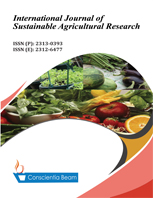Growing Jatropha Curcas and Jatropha Gossypiifolia as a Interculture with Sunflower for Control of Meloidogyne Javanica in Egypt
Abstract
The nematicidal potential of both Jatrophacurcas and Jatrophagossypiifoliaseedlings as ainterculture with sunflower cv. Giza 1 (1, 2, 3 and 4 plants per pot) againstMeloidogynejavanica was tested under a screenhouse conditions (30 ± 5 ºC) at the National Research Center, Egypt. The final population of nematodes and their rate of build up as well as the root gall index were significantly affected by the number of Jatropha plants when grown with sunflower together. There was a negative correlation between the number of Jatropha seedlings and the final population of nematode. The lowest nematode final population and rate of build up were determined at the highest number of Jatropha plants (4 plants per pot). The highest number of root gall index (4.7) was found on roots of sunflowergrown alone, while, the lowest numbers (0.8 and 1.3) were found in the roots of sunflower grown with four plants of Jatrophacurcas and Jatrophagossypiifolia; respectively. Effectiveness of Jatropha curcas was better against M. javanica than Jatropha gossypiifolia. This type of control is considered pollution-free, easy and inexpensive.

